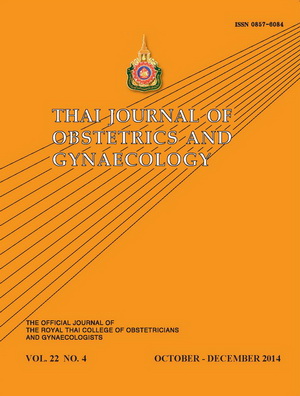A Correlation between First-void Morning Urinary Protein to Creatinine Ratio (UPCR) and 24 Hours Urinary Protein in Pregnancy with Suspected Preeclampsia
Main Article Content
Abstract
Objective: To evaluate a correlation between first-void morning urinary protein to creatinine ratio (UPCR) and 24-hour urine protein in pregnant women suspected of preeclampsia.
Materials and Methods: A total of 40 pregnant women suspected of preeclampsia were enrolled and admitted for 24-hour urine collection. Collected urine was divided into 2 parts, first-void morning urine and the remaining. First-void morning UPCR was determined and 24-hour urine protein was calculated by a combination of protein from both specimens. Significant proteinuria was diagnosed if the total 24-hour urine protein was greater than 300 mg. A correlation between first-void morning UPCR and 24-hour urine protein was estimated using Pearson product-moment correlation coefficient (r).
Results: Mean age was 31.0 ± 7.0 years and mean gestational age was 33.2 ± 4.6 weeks. Eight patients (20%) had significant proteinuria and were diagnosed as preeclampsia. A correlation between first-void morning UPCR and 24-hour urine protein showed a significant positive correlation with coefficient (r) of 0.76, p < 0.001. At the cut-off value of 0.3, first-void morning UPCR had sensitivity of 87.5% (95% CI 46.7 – 99.3) specificity of 96.9% (95% CI 82.0 – 99.8) for diagnosis of significant proteinuria.
Conclusion: First-void morning UPCR significantly correlated with 24-hour urine protein. It should be considered as an alternative method for detecting significant proteinuria in women suspected of preeclampsia.

